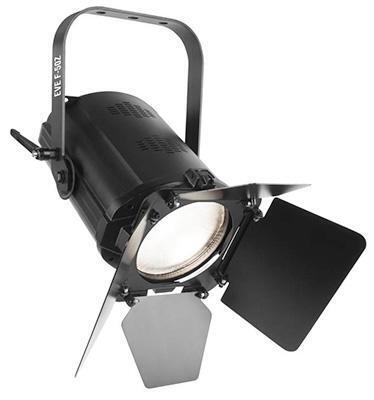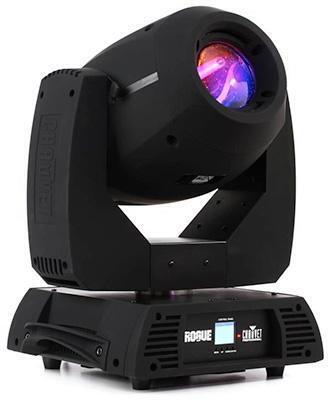Ellipsoidal, also known as Ellipsoidal Reflector Spotlight (ERS), is a light used to highlight certain subjects or stage pieces with a relatively narrow beam angle. This is best used for when you want to draw attention to a person by using multiple units. ERS lights always have adjustable focus and can have gobos placed in them to project patterns or logos.
PAR — Short for parabolic reflectors, these are lights used as wash fixtures. These lights can cover large parts of the stage to fill in gaps that the spotlights do not cover or to wash the entire stage. These fixtures typically do not have any sort of zoom or focus option, but come in a variety of lens types to get different beam angles. This is the most common type of fixture you will see, because it is generally the most cost effective while providing the most coverage.
— Short for parabolic reflectors, these are lights used as wash fixtures. These lights can cover large parts of the stage to fill in gaps that the spotlights do not cover or to wash the entire stage. These fixtures typically do not have any sort of zoom or focus option, but come in a variety of lens types to get different beam angles. This is the most common type of fixture you will see, because it is generally the most cost effective while providing the most coverage.
Fresnel – These fixtures are the happy medium between a PAR and an ERS. They have a zoom function but not a focus and usually cast a much “softer” light than ERS fixtures. This type of light also comes in handy when you cannot hang a fixture in an optimum location and need adjustable optics to help achieve the look you want.
– These fixtures are the happy medium between a PAR and an ERS. They have a zoom function but not a focus and usually cast a much “softer” light than ERS fixtures. This type of light also comes in handy when you cannot hang a fixture in an optimum location and need adjustable optics to help achieve the look you want.
Moving Head — These fixtures come in a variety of different flavors, such as a spot, wash, beam, and hybrid. Each of these names refers to the beam angle range of the fixture. Beam is the narrowest, spot is a little wider, wash is the widest, and hybrid could be any combination of those three. These units also have color capability, movement, gobo patterns, and a long list of other functions. As the most versatile option, they allow you to really take a show to a whole new level.
— These fixtures come in a variety of different flavors, such as a spot, wash, beam, and hybrid. Each of these names refers to the beam angle range of the fixture. Beam is the narrowest, spot is a little wider, wash is the widest, and hybrid could be any combination of those three. These units also have color capability, movement, gobo patterns, and a long list of other functions. As the most versatile option, they allow you to really take a show to a whole new level.
These are just a handful of the fixture types in the lighting world but are among the most common and widely used. With just these fixtures, you can create a professional show and provide almost any look you can imagine.
Hanging the Fixtures
Now that you understand the gear and can envision how you want the stage to look, what next? Here are a few techniques and guidelines on how and where to hang your fixtures to get the look you desire.
First and foremost, any time you are hanging fixtures, the most important thing is safety. Make sure when your fixtures are going in the air that they are flown by a qualified professional with the right hardware. Typically, all fixtures are attached to steel pipe or truss with lighting clamps. Many fixtures will use only one clamp, but some will use two. Always refer to the manufacturer specifications when hanging a fixture. Every fixture also needs to have a safety cable wrapped around the yoke or handle of the fixture and the pipe or truss it’s connected to.
Fixture Placement
So where do you place your fixtures? This depends on many variables, such as the desired look, ceiling height, and weight and throw distance of the fixtures. Here are a few different examples.
Single-point lighting: This is the simplest type of placement and in fact mimics something we see every day — the sun! It has the most natural look and can have a dramatic effect. It also draws attention, but can give a person onstage a very flat, two-dimensional look. Typically, when doing a single light from the front, you would want the light to be on-axis with the subject and about 30˚ up from the subject.
Two-point lighting: This is similar to single-point lighting, but it gives a more three-dimensional look to the subject onstage. Typically, there is one light coming from in front of the subject on-axis about 30˚ up. The second light is positioned behind the subject and is often a different color to add some dimension and create a sculpted look to the subject. The light coming from behind is usually 30˚–40˚ up and about 60˚–70˚ off-axis to provide depth and stay out of the audience’s eyes.
Three-point lighting: This next step is how most live productions choose to light their performers. Three-point lighting is a technique that eliminates most shadows from the audience’s perspective, which also makes it a great choice for keynote presentations and public speaking. Three-point lighting uses two lights out front, about 45˚ off-axis and 30˚ up. Then the third light is placed behind and about 30˚–40˚ up and 60˚–70˚ off-axis.
Four-point lighting: This technique comes in handy when video is involved. The previous techniques can be problematic for video, as they tend to have shadows. While shadows can be a good thing for many performances, they are not ideal when shooting video. Four-point light is exactly like three-point lighting, but the fourth light is placed out front, directly on-axis with your subject. With three lights out front, though, you will need to modify the intensity of each light so that they work well together to create a nice well-blended look. Some designers also add more lights to a backdrop or wash the back of the stage with color to create stage depth for the cameras.
